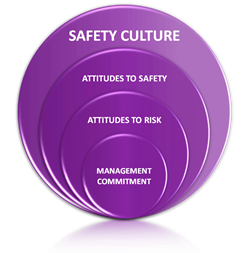safety culture survey – a behavioural approach
Workplace injuries and fatalities cost the British economy £13.4 billion in 2010/20111. While improvements to safety equipment and procedures have successfully reduced accidents, the effectiveness of this regulatory approach has reached another plateau2. The next significant improvement in safety performance will be achieved by taking a behavioural approach. A safety culture survey is the starting point for this.
Traditional safety surveys focus on equipment, processes and procedures. They do not provide insights into safety behaviours and attitudes to risk. By taking a behavioural approach with a safety culture survey, it is possible to assess how likely it is that employees will “walk the safety talk”.
improving safety performance with a safety culture survey
- Improve understanding of attitudes to safety
- Profile disposition to risk from low to very high
- Reduce accidents and insurance premiums
- Increase reporting of near misses
- Identify forward-looking safety metrics
- Target training where it’s most needed
- Benchmark safety performance
impact of human error
60-80% of workplace accidents are attributable to operator error3. Regardless of the equipment and training provided, some employees have a higher tolerance of risk and are less inclined to follow procedures, putting themselves and their colleagues at risk; they somehow feel that they can manage the consequences of their actions. Their “near misses” may go un-reported, making it even harder to identify areas at greatest risk of a serious accident.
corporate governance
Workplace safety is a corporate governance issue. For listed companies, the Turnbull guidance on the Combined Code on Corporate Governance requires robust internal controls covering a range of risks, including health and safety. For all organisations, a safety culture survey enables boards to practise effective corporate governance and directors to fulfil their duty of reasonable care, skill and diligence required by the Companies Act 2006.
our approach to safety culture surveys
Most organisations have the ability to conduct safety audits in house but gaining an objective understanding of human behaviour is much more challenging. Our extensive experience in the areas of organisational culture and leadership is a natural complement to the in-house expertise of health and safety practitioners.
A key strength of our approach is the use of multiple methods. We use two proven questionnaires, supported by management interviews. The questionnaires identify attitudes to safety and risk. They take a total of 10 minutes to complete and are aimed at operatives. They are non-attributable, so individual coinfidentiality is guaranteed. The management interviews take 20-30 minutes and are also confidential.
safety culture report
- An executive summary for decision-makers
- A detailed green, amber, red presentation of attitudes to safety
- An objective statement of risk ranging from low risk to very high risk
- A summary of manager interviews
- Further analysis by sub-groups
- Recommendations for the future
who is the survey aimed at?
- ports and harbours
- construction
- petrochemical
- offshore oil and gas
- emergency services
- security organisations
- manufacturing
- transport and logistics
why nova connection for a safety culture survey?
We have many years experience of organisational culture surveys. Our British Psychological Society accreditation means that you can be confident of our objectivity, fairness and professionalism.
- Health and Safety Executive, Costs to Britain of workplace injuries and work-related ill health: 2010/11 update
- Health and Safety Executive, Trends in work-related injuries and ill health since the introduction of the Health and Safety at Work Act (HSWA) 1974
- Examples include various studies cited by Aas, A. L. (2008) The Human Factors Assessment and Classification System (HFACS) for the oil & gas industry, International Petroleum Technology Conference; Aas, A. L. (2009) Probing human error as a causal factor in incidents with major accident potential. Third International Conference on Digital Society; Wiegmann, D. A., and Shappell, S. A. (2001). A human error analysis of commercial aviation accidents using Human Factors Analysis and Classification System (HFACS). DOT/FAA/AM-103, Office of Aviation Medicine, Federal Aviation Administration. Washington DC; the John A. Volpe National
- Transportation Systems Centre online piece on automobile driver error retrieved on December 10th. via www.volpe.dot.gov/infosrc/highlts/05/winter/focus.html



